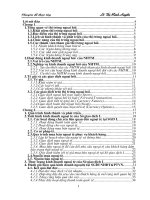How to compare 2 sound systems
Bạn đang xem bản rút gọn của tài liệu. Xem và tải ngay bản đầy đủ của tài liệu tại đây (140.18 KB, 14 trang )
How to compare 2 sound systems
Group 1
Vu Phuong Thao
Nguyen Anh Thu
Nguyen Thi Hong Lien
Main contents
1. Introduction
1. Introduction
1.1 Phoneme
• Phoneme, in linguistics, smallest unit of speech distinguishing one word (or word element) from another,
• as the element p in “tap,” which separates that word from “tab,” “tag,” and “tan.”
1.2 Phonemes are not letters
-
A letter of the alphabet may represent a phoneme
-
A phoneme is never a letter
-
It is a unit of sound
⇒ Phonemes are units of sound that exist in all the languages we know, whether or not they have ever been written
• 1.3 Phonemic versus non-phonemic differences
Phonemic differences
Non-phonemic/ non- significant differences
- Constantly used to distinguish words
- Never used to distinguish words
- Represented by phonemes
- Represented by the difference b/w the exploded or unexploded,
aspirated...
-Change the words
- Remain the same words
-
- Hundreds or thousands of non-phonemic differences
A relatively small number of phonemic
distinctions
1.4 A sound system
A system of habits
Great strength of the system
-
The use of the sound system of a language operates as a system of automatic and semi-automatic habits
⇒It is extremely difficult to change anything in that system
⇒There is a strong force binding the units-the phonemes- of any language in their complex of contrasts.
1.5 Transfer of native sound system
Production distortions
Perception blind spots
• Production distortions:
- the pronunciation of a German speaker learning English is quite different from that of a Spanish speaker learning English
- the distortions in the English pronunciation of a German speaker will bear great similarity to the distortions of other
German speakers
• Perception blind spots:
- Phonemic differences in the foreign language will be consistently missed if there is no similar phonemic difference in the
native language
1.6 Comparison of sound systems and applications
-
A means of predicting and describing the pronunciation problems of the speakers of a given language learning another
- The results obtained from the process of comparing 2 sound systems are great practical use for the preparation of
textbooks, tests, evaluation of materials, diagnosis of student problems
2. Problem Analysis: Sound Segments
2.1 In learning the sound system of a foreign language
physically
structure
not part of the
similar to the
structure
sound system
native
similarly
of the native
language
differently
language
similarly
differently
distributed
distributed
Learning of such phonemes occurs by simple transfer
without difficulty
Learning of these occurs more slowly, and difficulty with them is
more persistent
2.2 Analysis of sound systems
-
The object here is to find or prepare a linguistic analysis of the sound system of the language to be learned and a similar
description of the language of the learner.
-
The descriptions should include segmental phonemes and phonemes of stress, intonation, and juncture or transition.
They should include relevant data on the phonetic features of the phonemes and their variants and on their distribution.
These data constitute what is generally called the phonology of a language.
2.3 Comparison of units
- Take up each phoneme separately in comparing the sound systems of L1 and L2.
- The comparison of each phoneme includes 3 checks
(1)
Does the native language have a phonetically similar phoneme?
(2)
Are the variants of the phonemes similar in both languages?
(3)
Are the phonemes and their variants similarly distributed?
2.4 Location and description of segmental problems
-
Experience and experiments also show that the learner will have trouble hearing as well as producing the new phoneme.
-
E.g: there are some sounds that exist in English but not in Vietnamese and vice versa, such as
-
English also has consonant sounds not found in Vietnamese,
-
Even in learning the same foreign language, each linguistic background will have a different set of phonemes
representing problems for that group of speaker.
A)
The first check: the comparison of the phonemes as units, can be achieved quickly if we have a phonemic chart for each of the two languages, the
native and the foreign.
-) Both charts should be based on the same criteria of classification: points of articulation horizontally with front of vocal apparatus to the left of the
page; air stream variations vertically, with complete interruption at the top of the page, decreasing to the bottom.
B)
The second check: If the native language has a similar phoneme, is the phonetic shape of its variants similar also?
Eg: English «th» has 2 variants /θ/ or/ð/, but only one phonese in Vietnamese
C) The third check: Is the phoneme similarly distributed?
- Again we know from experience that even when the native language has a similar phoneme and the variants are similar, if it does not occur in the same
position as in the native language, the student will have trouble producing and hearing it in the position in which it does occur in the foreign language.









